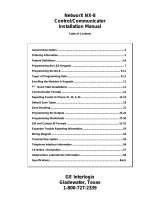
–ii–
Section 6: BASIC HARDWIRED ZONES 1-9 .................................................... 25
Common Characteristics of Hardwired Zones ...................................... 25
Wiring Burglary and Panic Devices to ones 1-8 .................................. 25
Wiring 2-Wire Smoke Detectors to Zone 1............................................ 26
Compatible 2-Wire Smoke Detectors .................................................... 27
Unsupervised Usage of Zone 1 .............................................................. 27
Wiring 4-Wire Smoke Detectors to Zones 1-8 ....................................... 27
Compatible 4-Wire Smoke Detetors ...................................................... 28
Configuring Zone 7 for Alternate Keyswitch Function ........................ 29
Wiring 2-Wire Glassbreak Detectors to Zone 8 .................................... 29
Compatible Glassbreak Detectors ......................................................... 30
Zone 9 Applications................................................................................ 30
Programming Hardwired Zones ............................................................ 30
Checkout Procedure for Hardwired Zones............................................ 32
Section 7: POLLING LOOP ZONES 10-86 ........................................................ 33
Polling Loop Overview ........................................................................... 33
Common Characteristics of Polling Loop Zones ................................... 33
Wiring/Addressing Polling Loop Devices .............................................. 33
Polling Loop Limitations........................................................................ 34
Polling Loop Supervision ....................................................................... 35
Programming Polling Loop Zones ......................................................... 36
Checkout Procedure for Polling Loop Zones ......................................... 38
Compatible Polling Loop Devices .......................................................... 39
Section 8: WIRELESS (RF) ZONE EXPANSION ............................................ 41
Common Characteristics of Wireless Zones.......................................... 41
Wireless Systems Available................................................................... 41
Wireless System Operation and Supervision ....................................... 42
Wireless System Installation Advisories .............................................. 42
Installation and Setup of 4281/5881 RF Receivers .............................. 43
Installation/Wiring of the 5800TM Module .......................................... 44
Programming The Wireless Receiver.................................................... 44
House ID Sniffer Mode........................................................................... 45
5700 Series Transmitter Setup ............................................................. 46
Wireless Zone Assignments for 5700 Series Transmitters .................. 47
Compatible 5700 Series Transmitters .................................................. 48
5800 Series Transmitter Setup ............................................................. 49
Compatible 5800 Series Transmitters .................................................. 50
Programming Wireless Transmitters ................................................... 52
Checkout Procedure for Wireless Zones................................................ 55
Section 9: RELAY OUTPUTS & POWERLINE CARRIER DEVICES ......... 56
Output Device Basics............................................................................. 56
Wiring the 4204 Relay Module.............................................................. 56
Wiring the 4300 Transformer................................................................ 57
Programming the 4204 Relay Module .................................................. 58
Output Programming Options Defined................................................. 58
Programming Output Devices ............................................................... 60
Zone List Programming ......................................................................... 63
Relay Voice Descriptors ......................................................................... 63





















